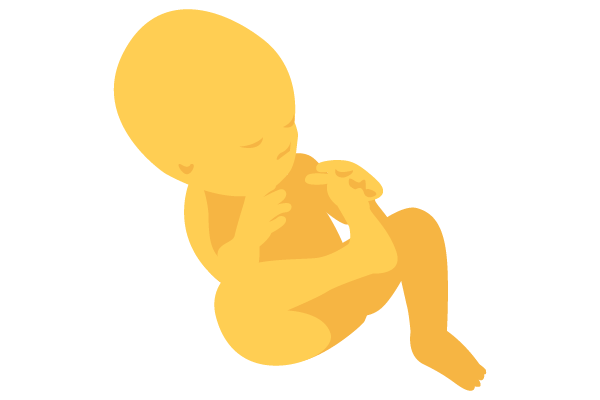
26 weeks pregnant
For information about weeks 24 to 27 of a twin or multiple pregnancy, tap here.
Here you are in week 26, with your second trimester drawing to a close! You are Baby are getting closer to your due date every day!
How’s Baby?
Baby is almost fourteen inches tall (31.5 cm), and weighs about 2 pounds (913 g), the size of an adorable butternut squash!
Most of Baby’s bodily systems and functions are now intact, and most of the rest of their development revolves around putting on height and weight. And while this may sound like a broken record, Baby is still spending lots of time building fat that will help them regulate their body temperature.
Baby’s eyes, which have been sealed for months, are finally starting to open, so they’ll be more responsive to light now. Baby’s vision is yet another reason to make sure you’re gaining weight at a steady rate, as low birth weight has been linked with infant vision problems.
Your little one is also preparing their immune system for birth by borrowing some of your antibodies. One theory about the development of Baby’s immune system is that because of this ‘share and share alike’ attitude, their immune system after birth will be well-suited to the environment that you’ve adapted to. This means that Baby could be well adapted to live happily in your home!
What's new with you?
As you move ever closer to your due date, you’ll gain more weight in the coming weeks before you give birth. You may also notice your breasts start to leak. And many folks experience restless leg syndrome (RLS) during the third trimester. If this affects you, you can try cutting down on caffeine, using compression stockings, or taking iron supplements (though be sure to talk with your healthcare provider about adding any supplements to your diet). You may also start to experience more difficulty sleeping as a result of hormones and the large physical newness that your growing womb now presents.
Braxton Hicks contractions are also going to continue as you move closer to your delivery day. They can be frustrating, but it’s important practice as your body gears up for delivery. As your delivery day grows closer, Braxton Hicks contractions may begin to mimic true labor more. However, this ‘false labor’ doesn’t progress and change your cervix the way true labor does. Braxton Hicks often includes irregular contractions, and can change or end if you shift your position or drink water. If you aren’t sure whether the contractions you’re feeling are the real thing, it’s better to be safe than sorry — give your healthcare provider a call and ask about it. Getting taken in by false labor is nothing to be embarrassed about, it just means you’re taking good care of yourself and Baby!
Reviewed by the Ovia Health Clinical Team
Read more
Sources
- A R Hayward. "The human fetus and newborn: Development of the immune response." Birth defects original article series. 19(3):289-94. Web. February 1983.
- "Differentiation of the gonads." Embryology. Human Embryology, n.d. Web.
- Mayo Clinic Staff. "Fetal development: The 3rd trimester." Mayo Clinic. Web. June 30, 2020.
- Committee on Obstetric Practice. "Weight Gain During Pregnancy: Number 548." American College of Obstetricians and Gynecologists. Web. Reaffirmed 2020.
- "Vital Considerations in Treating a Pregnant Woman." Pregnancy and RLS. Restless Legs Syndrome Foundation. Web. 2015.
- "Sleeping By The Trimesters." Sleep Foundation. National Sleep Foundation, n.d. Web.
- Mark A Curran, M.D. “Fetal Development.” Perinatology.com. Perinatology.com. March 31, 2019. https://www.perinatology.com/Reference/Fetal%20development.htm#1.




